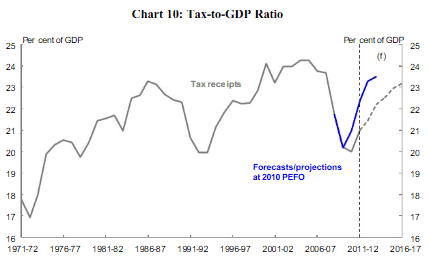The fallout from Treasury Secretary, Dr Martin Parkinson’s, speech yesterday on budget forecasting processes has continued, with economists questioning the Treasury’s forecasting abilities given the big writedown to budget revenues over the past year.
The above segment from ABC’s The Business summarises the debate well. As explained yesterday, the Treasury has effectively been caught-out by a sharper than expected fall in commodity prices which, when combined with the stubbornly high Australian dollar, has depressed growth in nominal GDP, adversely affecting tax collections (particularly company tax receipts).
The overall slide in revenues is perhaps best shown by the next chart, which shows the ratio of tax-to-GDP suffering it’s biggest decline since the 1950s, with the overall tax take hitting lows not reached since the early-1990s recession:

According to Dr Parkinson:
”From its pre-crisis level of 23.7 per cent the tax-to-GDP ratio fell to 20.1 per cent in 2010-11… This reflects both successive large cuts to personal income tax rates and a fundamental change in the relationship between the nominal economy and tax receipts”.
Lower revenues are expected to continue. Along with falling commodity prices, which will weigh on company profits and nominal GDP growth, the mining investment boom has caused a big pick-up in depreciation deductions from mining companies, which has led to mining companies paying 5% to 10% less tax than the mining sector as a whole, according to Dr Parkinson.
”Just to be clear, this is not a judgment about what the effective tax rate paid by mining companies should be. It is simply a statement of fact”.
Meanwhile, society has become accustomed to the good times, demanding a high level of government services and low taxation. At the same time, the population is ageing, which means that the proportion of workers supporting non-workers will rise, necessitating higher levels of taxation.
”We have a big gap between what the community demands of government and what it is prepared to pay… We have to think about savings or new sources of revenue”…
“We cannot just keep promising in different areas that we can put more and more money in”…
“If we are to deliver surpluses over time such that we can deal with the demographic challenge we confront, we’ve got to keep outlays to less than 24 per cent [of GDP], or we’ve got to increase receipts”.
Reading between the lines of Dr Parkinson’s speech, two things stand out. Firstly, that the Federal Government wasted the boom, failing to save enough during the good times and was too generous in cutting taxes and expanding middle-class welfare. Indeed, the The Parliamentary Budget Office (PBO) estimates a structural deficit between 0.25 per cent and 1.5 per cent of GDP in 2016-17:
“The PBO’s analysis suggests that the budget has been in structural deficit since 2006-07 or 2007-08 and while in decline, the structural deficit will persist until at least 2016-17”.
Second, partly as a result of this largesse, taxes will have to rise and expenditure fall, as the ageing population bites and Australia’s new (slower) economic reality sets in.

